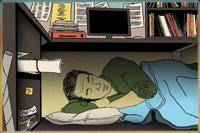The first time Marcelle Hutchins sat down to meditate, she put on a guided session, relaxed her shoulders and tried to close her eyes. She lasted two minutes.
“I had a deadline, and I thought, ’I don’t know if I can sit still this long,'” said Hutchins, who was working as a radio journalist.
At the urging of her father, a longtime practitioner, she tried again and managed to finish a 10-minute video on her third attempt. “I remember feeling this sense of joy and relaxation,” she said. “I used to be that person who said, ‘I can’t meditate.’”
Hutchins has since become a certified meditation teacher — and serves as an example that busy, restless people who try once should try again. Research shows a daily meditation practice can , improve and , among other benefits.
The trick is to get over that initial barrier. Experts say it’s more achievable when you throw common misconceptions out the window. For instance, many people try meditation only once because they feel they’re doing it wrong or that they can’t turn off their brain.
That’s not the point, says Tara Brach, who holds a doctorate in psychology and has trained more than 7,000 people to be meditation teachers.
“It’s not about stopping thoughts. The mind generates thoughts the way body creates enzymes,” she said. “It’s about being able to get larger than the thoughts and witness them.”
START SIMPLE
There is no right way to meditate, Brach stressed.
The key is to relax and focus on something in the present moment. Feel your breath pass through your nostrils, listen to a guided recording, mentally scan your body from head to toe, repeat a loving phrase to yourself or try countless other techniques.
You can sit on the floor, in a chair or on a cushion. If you can’t get comfortable, lie down. You don’t even need to close your eyes, though it’s recommended to try.
There is no standard amount of time to begin with, but set an achievable goal.
“You can customize it to who you are,” said Brach, author of several books, including “Radical Acceptance: Embracing Your Life With the Heart of a Buddha.”
“Start with the most you can comfortably do without having to feel like you want to quit,” she said
That could mean starting with as little as a few minutes, said John Mitchell, an associate professor in psychiatry and behavioral sciences at Duke University who uses . The goal should be working meditation into a routine and focusing on the quality of the practice, not the quantity.
“Then the question is, what do we do to create success so we can have momentum and start off without feeling like you’re failing right way?” he said.
WHEN YOU CAN’T SIT STILL
When you inevitably get distracted — everyone does — notice the thought or urge to move, acknowledge it and bring your attention back to where you are.
Instead of judging yourself, get curious for a minute about the nature of restlessness, Brach said. Ask yourself, “What does it really feel like if I want to jump out of my skin?”
Then take a long, deep breath, and sit for one more minute. If you still want to move, then move. But Brach recommended doing so mindfully. Stand up, do a light stretch, take a deep breath and sit again. You will be surprised at how that sense of restlessness will change over time, she said. “It will evolve.”
If the restlessness builds to a point where you are uncomfortable, consider taking a slow, meditative walk, Mitchell said. Stay alert but calm, focusing on the sounds, sights and smells around you, or maybe on the sensation of the wind and sun on your face.
“You’re not restricted,” he said. “You don’t have to sit there in silence and be still all the time.”
TOMORROW, AND THE NEXT DAY, TRY AGAIN
After sticking through the first session, you will almost certainly feel calmer, no matter the length. But to get the full benefits, , research shows you need to practice consistently.
For people having trouble starting, that can be daunting, but Brach suggested trying a few techniques to find the right fit.
“It takes a bit of experimentation to find the style of meditation that works for your particular body, mind and personality,” she said.
Luckily, there's a universe of free meditation resources online.
“Nobody reading this needs to go buy anything,” she said.
—-
EDITOR’S NOTE: Albert Stumm lives in Barcelona, Spain, and writes about food, travel and wellness. Find his work at








































